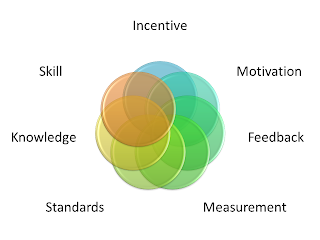Training Vision
Vision statements can be a few words or a paragraph. It is advisable to keep the statement as short as possible so everyone in the organization can internalize it. This is perhaps the most significant statement a management team can make to inspire everyone to stay true to the company's identity. This can also apply to a division, a team, a department, etc. Vision statements apply equally to companies, government entities and non-profits, as well as, individuals.
"Blue skying it" is important. Your vision is an idealized state for your training organization. It is the view of what you want for the future and encompasses your mission, values, goals, and objectives. It is what the organization wants to become. If possible, try to summarize your vision using a powerful phrase in the first paragraph of your vision statement. This will enhance the effectiveness of your vision statement. Vision statements also define the organizations purpose in terms of the organization's values rather than bottom line measures. The vision statement communicates both the purpose and values of the organization. A vision statement describes how the future will look if the organization achieves it's mission. (See Mission )
Here is an example of a potential Training Vision:
"We will provide organizations with the skills and knowledge to prosper, while creating a satisfaction level with (our) offerings that results in delighted customers."
Substitute the name of your organization for the: (our).
Some other examples examples:
The differences:
"Blue skying it" is important. Your vision is an idealized state for your training organization. It is the view of what you want for the future and encompasses your mission, values, goals, and objectives. It is what the organization wants to become. If possible, try to summarize your vision using a powerful phrase in the first paragraph of your vision statement. This will enhance the effectiveness of your vision statement. Vision statements also define the organizations purpose in terms of the organization's values rather than bottom line measures. The vision statement communicates both the purpose and values of the organization. A vision statement describes how the future will look if the organization achieves it's mission. (See Mission )
Here is an example of a potential Training Vision:
"We will provide organizations with the skills and knowledge to prosper, while creating a satisfaction level with (our) offerings that results in delighted customers."
Substitute the name of your organization for the: (our).
Some other examples examples:
- Microsoft's vision: "A personal computer in every home running Microsoft software."
- Centers for Disease Control vision: "Healthy People in a Healthy World."
- Rensselaer Research Libraries: "As Rensselaer moves towards its goal of achieving prominence as a top-tier world class technological research university, the Libraries' vision is to support the Rensselaer Plan by providing seamless access to the widest possible spectrum of information resources relevant to Rensselaer's research and learning communities and to be a distinctive campus facility serving a variety of community needs."
- Alternative Rensselaer Research Libraies' vision: "Seamless access to the widest possible spectrum of relevant information resources to the university community."
The differences:
- Vision: Defines where the organization wants to be in the future. It reflects the optimistic view of the organization's future.
- Mission: Defines where the organization is going now, basically describing the purpose, why this organization exits.
- Values: Main values protected by the organization during the progression, reflecting the organization's culture and priorities.
- Strategic Planning: Saves wasted time, every minute spent in planning saves ten minutes in execution.




This is really interesting and helpful for all viewers!!! Thanks and see more at:- http://www.doortraining.co.in/
ReplyDelete